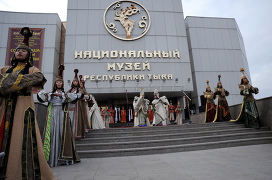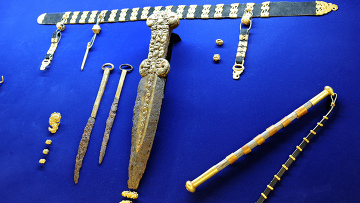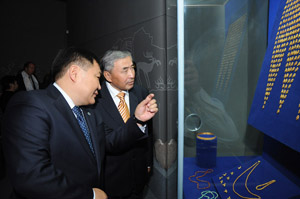|
 The only nephew of the British Queen, the founder of the business brand Linley, viscount David Linley, visited on November 2, 2008, the official opening of the exhibition “Treasures of the Valley of Kings. The King’s Kurgan Arzhaan-2”, in the National Museum of Tuva. The exhibition, located in two halls of the new museum building, consisted of the unique finds from the Scythian kurgans of Pii-Khem district of Tuva – the results of archeologic excavations of years 1971-1974 and 2001-2002. The only nephew of the British Queen, the founder of the business brand Linley, viscount David Linley, visited on November 2, 2008, the official opening of the exhibition “Treasures of the Valley of Kings. The King’s Kurgan Arzhaan-2”, in the National Museum of Tuva. The exhibition, located in two halls of the new museum building, consisted of the unique finds from the Scythian kurgans of Pii-Khem district of Tuva – the results of archeologic excavations of years 1971-1974 and 2001-2002. “The discoveries from the Valley of the Kings are a world heritage, a collection comparable in its significance to the famous Seven Wonders of the world,- emphasized at the ceremonial opening the Premier of Tuva, Sholban Kara-ool, who actively fought to have the treasures returned to their land of origin, - Any museum of the world would be happy to have these treasures among their exponates. Their way home was very complicated. But now the finds are back, in Tuva. And now they are accessible to all the citizens and guests of Tuva. I believe that their magnetism will bring their own audience to the center of Asia, people who value high art, and curious minds who are interested in seeking the sources of the civilizations of the world.”
 The first obstacle to the return of the collection of artifacts from kurgan “Arzhaan-2”, discovered in 2001 by the Russian-German expedition under the leadership of Konstantin Chugunov, was the lack of a suitable building for keeping such valuable materials. The government mobilized all effort to finish the construction, which dragged on for more than 17 years, and the new museum building finally opened on February 7 of this year. The first obstacle to the return of the collection of artifacts from kurgan “Arzhaan-2”, discovered in 2001 by the Russian-German expedition under the leadership of Konstantin Chugunov, was the lack of a suitable building for keeping such valuable materials. The government mobilized all effort to finish the construction, which dragged on for more than 17 years, and the new museum building finally opened on February 7 of this year.
The next reason why the State Museum Hermitage was unwilling to agree to return the gold from Tuvan kurgans, was the lack of the necessary security system for protection of the Scythian masterpieces. The apportioning of financial means for this purpose out of the republic budget was blocked by the Legislative House of the Great Khural of Tuva. The help for providing the security of the building with videocameras, bulletproof glass cases, armored doors and alarm signals, came from the senator of Tuva, Sergei Pugachev.
 Among the dignitaries who came to Tuva for the opening of the exhibition Among the dignitaries who came to Tuva for the opening of the exhibition
on the invitation of The Chairman of the government of Tuva, were senator Sergei Pugachev, Princess Salimah, who is actively involved in charity activities, the acting director of the famous British firm Asprey, which specializes in the sale of luxury items, Lord Bruce Dundas, and the scientific worker of the Hermitage, Konstantin Chugunov.
The new exhibition,
 “The Treasures of the Valley of the Kings. The Royal Kurgan Arzhaan-2”, was produced by the workers of the National Museum. “The Treasures of the Valley of the Kings. The Royal Kurgan Arzhaan-2”, was produced by the workers of the National Museum.
“The conception of the production and its realization is a work of world standard,- highly appraised the exhibition viscount Linley. – I am impressed by what I have seen, by the highest level of mastery of the ancient craftsmen, their filigree technique, the tasteful, artistic representations of animals, accurate in the smallest detail. Contemporary designers could look for new ideas to this three thousand year old art. This unique collection, I believe, will prove to be a new source of inspiration to me in my work.”
 The clothing of the buried King’s guard was covered in six thousand miniature gold plaques, sewn on in an intricate pattern, there were head dresses, hair ornaments, pendants of gold, turquoise, amber, a massive gold torc of the leader, on which the hand of the Scythian craftsman depicted intertwined patterns of likenesses of horses, reindeer, panthers – all of these are true masterpieces of the craft of jewelry making. Even with contemporary level of technology, it could be imitated by only some individuals, explain the museum workers. The clothing of the buried King’s guard was covered in six thousand miniature gold plaques, sewn on in an intricate pattern, there were head dresses, hair ornaments, pendants of gold, turquoise, amber, a massive gold torc of the leader, on which the hand of the Scythian craftsman depicted intertwined patterns of likenesses of horses, reindeer, panthers – all of these are true masterpieces of the craft of jewelry making. Even with contemporary level of technology, it could be imitated by only some individuals, explain the museum workers.
The opening of the long-awaited exhibition gave the stimulus for a whole sequence of various festive events, dedicated to the Day of National Unity. The organizers see this as deeply symbolic. This holiday is a symbol of the unity of people of various faiths, ethnicities and conditions for reaching great goals,
 but it is also symbolic of connections throughout epochs and generations. It is about knowledge of one’s history and ability to be proud of it. but it is also symbolic of connections throughout epochs and generations. It is about knowledge of one’s history and ability to be proud of it.
Schoolchildren who finished the first quarter of the school year with excellent results were invited to the exhibition. On this holiday, the museum was visited by approximately 1000 schoolchildren.
“Today’s event is not significant mainly because the Scythian gold returned to Tuva. Its main significance lies in the fact that based on this heritage, we can bring up the young growing generation. – noted Sholban Kara-ool.
The exhibition “Treasures of the Valley of Czars” will be a permanent exhibit of the National Museum of Tuva.
Photographs ( by Vitaliy Shaifulin, Vladimir Terebenin):
- The welcome of the guests at the entrance to the National Museum of Tuva.
- Artifacts from kurgan “Arzhaan-2”.
- Viscount David Linley, his wife Serena, Lord Bruce Dundas and his wife Ruth Kennedy are becoming acquainted with the exposition of “Treasures of the Valley of Czars”.
- Golden cup from kurgan Arzhaan-2.
- Premier of Tuva, Sholban Kara-ool and ex-premier Sherig-ool Oorzhak.
- Golden deer, top of a hairpin.
Some little-known facts about the archeological discoveries in the Valley of the Kings.
…Scientific research in the Valley of the Kings first started in the year 1916, when Russian traveler and researcher of Siberia, A. Adrianov excavated one kurgan…
…In the kurgan Arzhaan-1, excavated in 1971-1974, by the expedition led by Mongush Mannai-ool and Mikhail Gryaznov, there was a central log structure and 70 analogical log structures with log ceilings. To build them, 5000 larch logs were used…
…Kurgan Arzhaan-2 was initially selected for archeological excavation for a prosaic reason – it was badly damaged during construction of a highway in the ‘70’s…
…The excavation of the kurgan Arzhaan-2 went on from 1998 to 2002…
…After the discovery of the unique artifacts, Germany paid for one week of security services of two machine gunners. Another week of security was paid for by the Ministry of Culture of Tuva, but after that the money had run out. The security at the site was thereafter provided by the Pii-Khem friends of the archeologists, armed with their hunting firearms…
…After the security was removed from the excavation site, everybody understood that it was dangerous to keep such valuable items in the field. The gold was packed into a box, and the chief of a private security company in Turan, Sergei Kolovskiy, a friend of one of the St. Petersburg archeologists, agreed to keep it in a safe. However, one of his colleagues reported it to his superiors, and Kolovskiy was reprimanded for taking on such a responsibility on his own cognizance. But the gold still had to be kept in a protected area, and Kolovskiy suggested that they put it into a safe at the local savings bank. The bank staff acted with understanding, and did not take a single kopek for it…
…When the gold was taken from the site of the excavations to Kyzyl, because of the lack of funds, it was practically impossible to put the priceless package into a bank in the capital. Again, local private contacts had to be utilized. Before being sent off to St. Petersburg, the treasure from Arzhaan-2 kurgan was kept in the apartment of the journalist Dina Oyun, who placed her apartment at the disposal of the archeologists….
…All the weapons found in the burial “Arzhaan-2” were made of iron, which was only just beginning to come into use at that time, and therefore was more valued by the nomads than gold…
…The exhibition “Royal graves of the Scythians”, which took place from July 6, 2007 to May 31, 2008 in several cities in Germany, was seen by more than 300 000 people…
(From Russian SMI on Arzhaan-2).
Mysteries of the Valley of the Czars
Nobody remembers exactly anymore how the Valley of the Kings got its name. The local population, who was firmly convinced that only royalty was buried in these kurgans, believe that the name was born in time immemorial. As soon as the snow disappears in the steppe around the Arzhaan settlement, archeologists will go back to continue excavations. As Konstantin Chugunov believes, it cannot be ruled out that also the neighboring kurgans hold riches, which were not touched by tomb robbers. Chugunov has been studying Scythian burials for almost 20 years. Having studied uncountable historical and kartographic materials, he came to the conclusion that the Valley of the Czars in Tuva has tremendous potential from archeological point of view. Many kurgans are located here, surrounded by mysterious ritual stone encirclements. It was believed that most of the kurgans had been robbed even in the ancient times, but Chugunov and his colleaques from the German Archeological Institute (DAI), Professor Herman Parzinger and Dr. Anatoli Nagler decided to take a risk.
So, in May of 2001, a joint Russian-German archeological expedition went to Tuva. It was organized by the Central Asian archeological expedition, based in the St.Petersburg branch of the NII of Russia, of the cultural and natural history department of RAN.
The Eurasian Department of German Archeological Institute was the international partner.
(Journal “Itogi”, March 2004)
What did they find?
In the deep quadrangular pit, there was a well-preserved log structure with double walls made of logs of Siberian larch. On the carefully worked floor, there was a double burial – a man and a woman, attired in clothing decorated with small sewn-on gold plaques. Their head dresses were decorated with gold plaques in the shape of horses, deer, panthers. The woman’s head dress was crowned with hairpins with engraving in so-called Scythian animal style. One of these was topped by a sculpture of a standing deer. In the area of the neck and chest, there were earrings, multiple pendants and beads from gold, turquoise, and amber. Around the man’s neck, there was a massive gold torc – a symbol of the ruler. The entire surface of the torc, as well as of the other objects, was decorated with images of animals , and appeared to be, in its way, a virtual encyclopedia of the art of the nomads of Central Asia. The pants of the buried King were over-sewn by fine gold beads, the boots were covered with gold leaf. In front of the faces of the buried persons, there were bronze mirrors. Next to the woman, there was a gold pectoral, leather containers with grains, there was a wooden scoop, and bronze and stone incense burners. Next to the man, there was a decorated belt, with a bow, quiver and a war axe fastened to it.
A special place in the main burial complex was reserved for iron weapons, which were encrusted with gold. Careful restoration work by the workers of the Hermitage permitted us to view these masterpieces of ancient master craftsmen.
The felts, fabrics, leather items and clothing were not preserved, but the gold plaques and beading which decorated them, allowed the reconstruction of the furnishings of the funeral chamber and the buried persons.
( From materials published on the official site of State Museum Hermitage. http://www.hermitagemuseum.org/ )
Chugunov – “Russian Schliemann”
Soon after the excavations of “Arzhaan-2”, the leader of the expedition, Konstantin Chugunov, received the nickname “Russian Schliemann”. It is not very fair – in contrast to Schliemann, Chugunov is a professional archeologist – but it accurately reflects the resonance of his discoveries. The burial-memorial complex, with the central structure of 80 meter diameter, proved to be an intact, untouched by robbers, burial of the Czar’s guard, their family members, and horses. The multiplicity of gold jewelry, decorations of weapons, unbelievable, to this day, in these areas delicacy of workmanship of the materials, the wonderful state of preservation of the constructions, and the intactness of the contents of the tombs, became a source of astonishment of laymen as well as the specialists, a source of scientific as well as political disagreements, and source of interest of “black market” archeologists. We can disabuse those: such discoveries happen only once in several centuries, there is no reason to hope for more.
(“Kommersant”, March 2004).
Encyclopedia of Scythian animal art says director of the National hermitage Museum, Mikhail Piotrovskiy
“ This is a whole encyclopedia of the Scythian animal art, because here one can see all the animals that lived in these regions: panthers, lions, camels, reindeer. This is the true Scythian style of the Altai region, which gradually infiltrated the Black sea region, until, finally, it reached Ancient Greece. The success of the excavations was a result of hard work, and of course, luck.”
(Journal “Itogi”, 2002)
There is no analogy to these discoveries in archeology
The chief of the Central Asian expedition, scientific worker of the Hermitage, Konstantin Chugunov: “There is no analogy in archeology to the finds from kurgan Arzhaan-2. All the patterns of the Scythian triad are extremely well developed”, so that at first, we could not imagine that they were created earlier than in 6th Century before our era. Thorough analysis of both “royal” burials and the tombs not belonging to the members of Scythian nobility, showed that they were from 7th Century before our era. This totally turns around the concepts about nomadic cultures of Asia: about the origin and evolution of Scythian art, which completely overshadows the art of Ancient Greece, which was contemporaneous to it. All the relationships have to be re-examined in a totally different key. The extreme old age of these discoveries is evidence that the Scythian tribes came to the Black Sea area from Central Asia.”
(“Izvestia”, 2002)
Masses of questions
Arzhaan-2 brought a colossal amount of scientific information, the work-up of which is far from finished, and generated masses of new questions. Where did the Central Asian nomads get these riches (just in the main burial, the aggregate weight of gold was more than 20 kg, not counting the fine beading)? Where and from whom did Scythian craftsmen learn the technique of gold working? When did they learn the artistic finesse of the “animal style”? What instruments did they use to work the gold and bronze – until now, it was thought that they did not know how to make steel?
(“Komsomolskaya Pravda”. January 2004)
|
|
